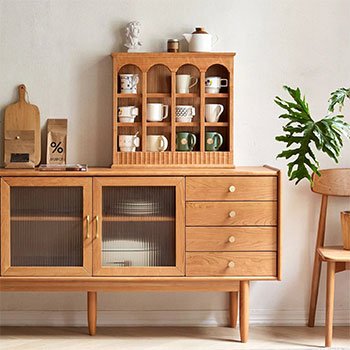One of the most common perpetrators of wood damage is its contact with water. Water can ruin your wood pieces and cause them to swell, warp, and rot with mold.
While wood is a sturdy material you can have for your home, it’s still vulnerable to water damage. Hence, buying new furniture isn’t a practical solution for everyone.
If you want to salvage your pieces, Fancyarn will share how to fix your wood furniture. Consider these tips and tricks to make them look new. Make sure to also avoid contact with water as much as you can.
Why Does Wood Swell?
Swollen wood can easily detract from the beauty of your furniture, making it appear aged and scuffed. But understanding why your wood is swollen will help you maintain your wood furniture and save money in the long term.
It is a natural procedure in that wood absorbs water. But if you apply a waterproof sealant, it won´t absorb any water. When your wood furniture absorbs water, the water molecules fill the spaces between the cellulose fibers in the wood. As a result, it causes the wood to expand or swell.
Depending on the type of wood furniture you have, the swelling will occur. Moisture content or air humidity can also affect your wood furniture. It is not necessary that the wood touches water directly.
The repair process is not difficult, and with a little time and effort, that piece of water-damaged wood furniture will be back in use in no time. Looking good as new and repaired smartly enough, so it’s not likely to happen in the future.
Tips And Tricks To Fix Your Wood Furniture.

Here are some easy and simple steps that you can follow in order to bring that furniture back to what it used to be.
Let The Furniture Dry.

Allow your water-damaged piece of furniture to dry before attempting to repair it. The longer the wood is wet, the more likely it is to warp or crack.
Be sure to wipe off any residue and place it in a warm and dry space. Use a fan or hair dryer to help speed up the drying process. The temperature of the hair dryer should be low. If the furniture is very wet, you may need to place it in a well-ventilated area or use a dehumidifier.
Use An Iron

With swollen wood furniture, a straightforward approach is to use an iron. Yes, we are not joking, an iron.
You start covering your furniture with a soft cloth or towel above the stains. Set your iron to a low temperature. Hold the iron down on the rag for a few seconds.
Be careful not to hold the iron in the same place for too long, as this could further damage the wood.
Iron constantly until you don´t see any water stains. If your furniture is too wet, repeat the process. Otherwise, try other options.
Use A Needle Or Printer.
Moisture (humidity) in the air gets into the wood and causes it to shrink, swell, and bubble up. Fortunately, removing these bubbles with a needle or a printer is possible.
When using a needle or printer, pierce the bubble from the side, not the top or center, to prevent any overlap of the excess material inside the bubble.
With good wood glue, you will place it inside the needle and gently push it where your water bubble is.
Push the wood gently down; it should feel soft. If you have applied correctly, the remaining glue should come out of the cracks.
Wipe away the excess glue, place plastic over the crack with some books, and let it dry. The bubble should be flat within a couple of days, with the pressure of the books plus the glue.
After you have done this process, you can move to the next step. Here is a video for better understanding of this procedure.
Sanding And Finishing

Once the furniture is dry, you can proceed to sand and finish the swollen furniture.
Reminder: Protect yourself by wearing safety glasses and a mask before you sand.
You can just use a piece of sandpaper, fold it and sand it placing even pressure. You need to brush away any dust that has accumulated.
If you have a larger surface to sand, you can use a belt sander and a finishing sander. The belt sander will remove every layer from the surface, any ring stains, scuffs, and scratches. The finishing sander helps restore the smooth finish before you coat it with your chosen paint or varnish.
Once it is done with sanding, use furniture oil on it. Rub the ointment for about 15 to 20 minutes. The wood will absorb the oil with the warmth you generate. Once this is done, a different rag or cloth is used to clean the surface and ensure no oil residue.
Flattening Wood
This can sound contrary to all the above steps mentioned. But you can fix swollen surfaces if you flatten the wood. The procedure starts with moisturizing your furniture evenly.
If necessary, you can also use a spray bottle or garden hose as a wood moisturizer. The size and thickness of the wood item would determine the quantity of water you need to achieve this wetting.
Next, place the damp board or swollen furniture on a workbench or the top of a counter with the wet side of the wood surface facing down. This will keep the damp side moist and the dry side exposed to air. Add a little weight on the board or furniture to help flatten the wood and leave it to sit for 24 hours before rechecking it.
Wood Protectors – How To Protect The Wood From Moisture?

Water damage can make any wood seem unsightly. But prevention, they say, is cheaper and better than cure. So, here are ways to prevent water damage.
Use An Oil Finish.
Oil finishes are necessary for your wood furniture maintenance. They repel water from the surface and treat the wood as well.
Oil finishes improve the overall look of your furniture and protect it from water damage. You will find different combinations of them depending on the type of wood you want to treat.
Plus, you can oil your wood furniture weekly, monthly, or just twice a year.
Use Stain Sealants.

Sealants create a waterproof barrier that prevents water from entering the furniture. Sealants provide, as a result, a longer-lasting life to your wood furniture.
You only need to apply the product on your furniture with a cloth and let it dry. After some hours, you can use your furniture again.
Wrapping Up
Water damage can be a destructive and devastating experience for any homeowner, but it doesn’t have to mean the end of your wood furniture. There are a few things you can do to try to fix it.
First, let it dry; using an iron also helps. Once it is dry enough, you can sand, place oil, add some stain sealand, and try to leave them in a room where they can stay dry.
If you live in a humid area, we recommend using a dehumidifier.
If you were wondering which wood furniture is better, click here to learn more.





